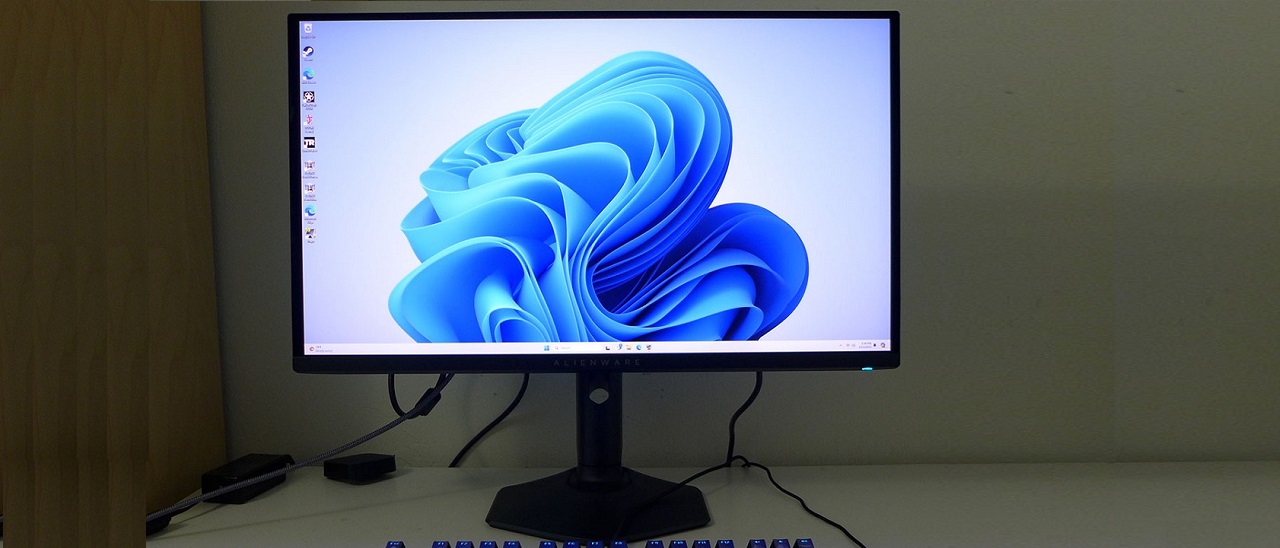Tom's Hardware Verdict
The Alienware AW2725DF is a near-perfect display for gaming or productivity when space is limited. It has incredible response and smoothness while delivering a stunningly colorful and accurate picture.
Pros
- +
Stunning image
- +
Larger color gamut than other OLEDs
- +
Perfect motion resolution and super quick response
- +
Lots of convenience features for gaming and productivity
- +
Solid build quality
Cons
- -
No internal speakers
- -
No analog headphone jack
Why you can trust Tom's Hardware
In my early days as a display reviewer, I waxed fantastically about the idea of a desktop OLED monitor. The landscape in 2013 was far different than today. Then, the hot tech was IPS, and things like G-Sync and fast refresh rates were rare. I spoke about contrast, which is still the most important thing, and imagined that we would never see anything better than 1,000:1 from an LCD panel.
I don’t often eat my words, but today, I’m enjoying them with a nice remoulade. Desktop OLEDs are not just here; they’re available in force. I’m looking at my recent reviews and those I’ll be writing soon, and they’re almost all OLEDs. My fantasy has become a reality, as OLED computer monitors offer many advantages. Not only do they have true blacks, but they also deliver large color gamuts and the smoothest motion processing of any display technology. They’re literally a dream for gaming and productivity alike, making them popular among the best gaming monitors.
If you’re looking for a flat 27-inch 16:9 screen, Alienware makes a splash with its AW2725DF. It doesn’t break ground with its QHD resolution, Adaptive-Sync, HDR or wide color gamut. But it does set itself apart with a 360 Hz refresh rate. And as you’ll soon see, it’s one of the fastest monitors I’ve ever tested.
Alienware AW2725DF Specs
| Panel Type / Backlight | Organic Light-Emitting Diode |
| Row 1 - Cell 0 | Quantum Dot Film |
| Row 2 - Cell 0 | (QD-OLED) |
| Screen Size / Aspect Ratio | 27 inches / 16:9 |
| Max Resolution and Refresh Rate | 2560x1440 @ 360 Hz |
| Row 5 - Cell 0 | FreeSync: 48-360 Hz |
| Row 6 - Cell 0 | G-Sync Compatible |
| Native Color Depth and Gamut | 10-bit / DCI-P3+ |
| Response Time (GTG) | 0.03ms |
| Brightness (mfr) | 250 nits SDR |
| Row 10 - Cell 0 | 400 nits HDR |
| Contrast | Unmeasurable |
| Speakers | None |
| Video Inputs | 2x DisplayPort 1.4 |
| Row 14 - Cell 0 | 1x HDMI 2.1 |
| Audio | None |
| USB 3.2 | 1x up, 3x down |
| Row 17 - Cell 0 | 1x USB-C |
| Power Consumption | 36.5w, brightness @ 200 nits |
| Panel Dimensions WxHxD w/base | 24 x 16-20.3 x 9.6 inches (610 x 406-516 x 244mm) |
| Panel Thickness | 2.7 inches (68mm) |
| Bezel Width | Top/sides: 0.4 inch (9mm) |
| Row 22 - Cell 0 | Bottom: 0.6 inch (14mm) |
| Weight | 14.1 pounds (6.4kg) |
| Warranty | 3 years |
Speedy QHD OLEDs are fairly common, but the ones I’ve covered have topped out at 240 Hz. That’s plenty fast, and when compared to a 240 Hz LCD, the OLED is much smoother. The AW2725DF’s 0.03ms response time delivers perfect motion resolution without needing strobing or overdrive. Even a 540 Hz LCD like the Asus PG248QP won’t impart a feel and response quite like this. And here’s the best part: nearly every OLED can do this. There's no going back once you’ve seen a fast OLED in action.
The AW2725DF runs at 360 Hz without overclock. Though its QHD resolution presents a lighter workload than a 4K screen, you’ll still need a quick video card to realize its full potential. Whether it is worth the extra coin over a 240 Hz screen may be a point to consider, but there’s something else here. The AW2725DF has a significantly larger color gamut than the other 27-inch QHD gaming monitors I’ve tested, including Mini LED models.
Like any OLED, the AW2725DF isn’t super bright, but it is bright enough, with around 250 nits available for SDR content and 450 in HDR mode. Color accuracy is excellent out of the box, without needing calibration. And there’s a usable sRGB mode for those needing gamut control.
Gaming is clearly the focus here with the aforementioned 360 Hz and Adaptive-Sync. The AW2725DF hasn’t been certified by Nvidia at this writing but should be by the time you read this. It runs FreeSync from 48-360 Hz through its two DisplayPort 1.4 inputs. You also get HDMI 2.1, which works up to 144 Hz and is perfect for consoles and VRR.
Convenience is addressed with five total USB ports, including USB-C, two of which are easily accessed from the front. Internal speakers and a headphone jack are missing. There are multiple sniper modes and aiming points, plus a suite of timers and display alignment marks for multi-screen setups. Attractive LED lighting appears around the back with a large Alienware logo that plays a variety of colors and effects. Build quality is firmly in the premium category.
I have yet to find an Alienware product or an OLED screen I didn’t love, and the AW2725DF looks to carry on that tradition. Let’s take a look.
Assembly and Accessories
The AW2725DF comes in Dell’s molded pulp packaging rather than crumbly foam. The screen, upright and base assemble without tools to create a solid unit. The base seems a bit small, but the panel is light enough to remain stable. The power supply is internal, so you get an IEC cord along with DisplayPort, DP-to-USB-C and USB-AB. There is no HDMI. You also get a soft cloth to clean the screen, a pictorial setup guide, a plastic input cover and a factory calibration data sheet whose data I verified in testing.
Product 360
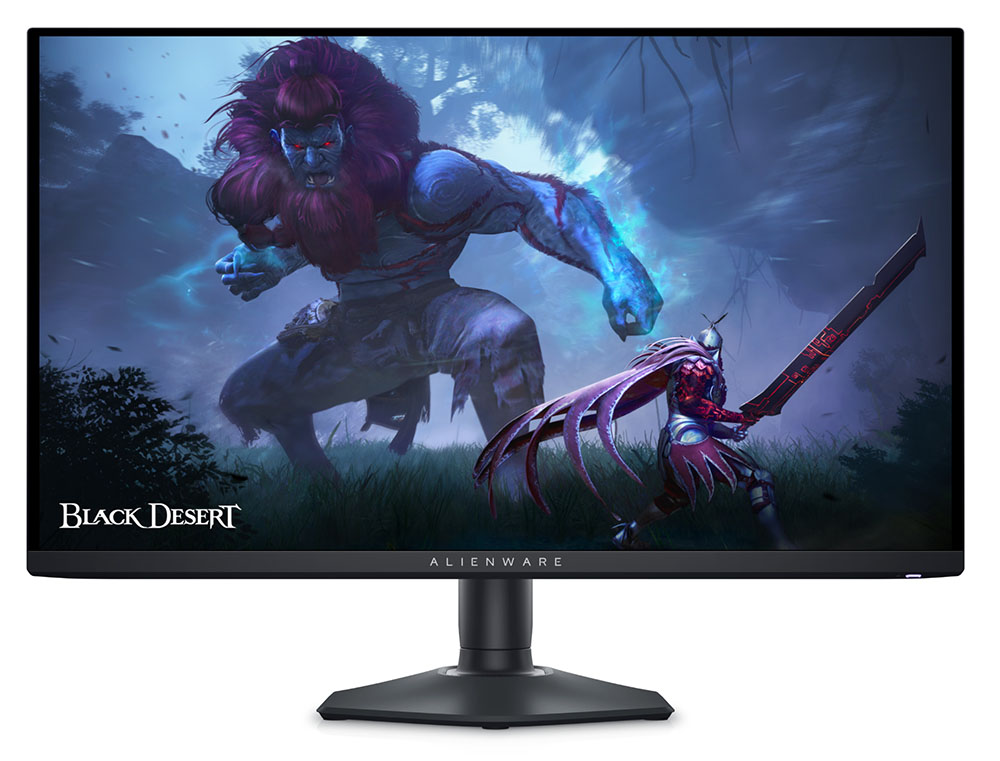
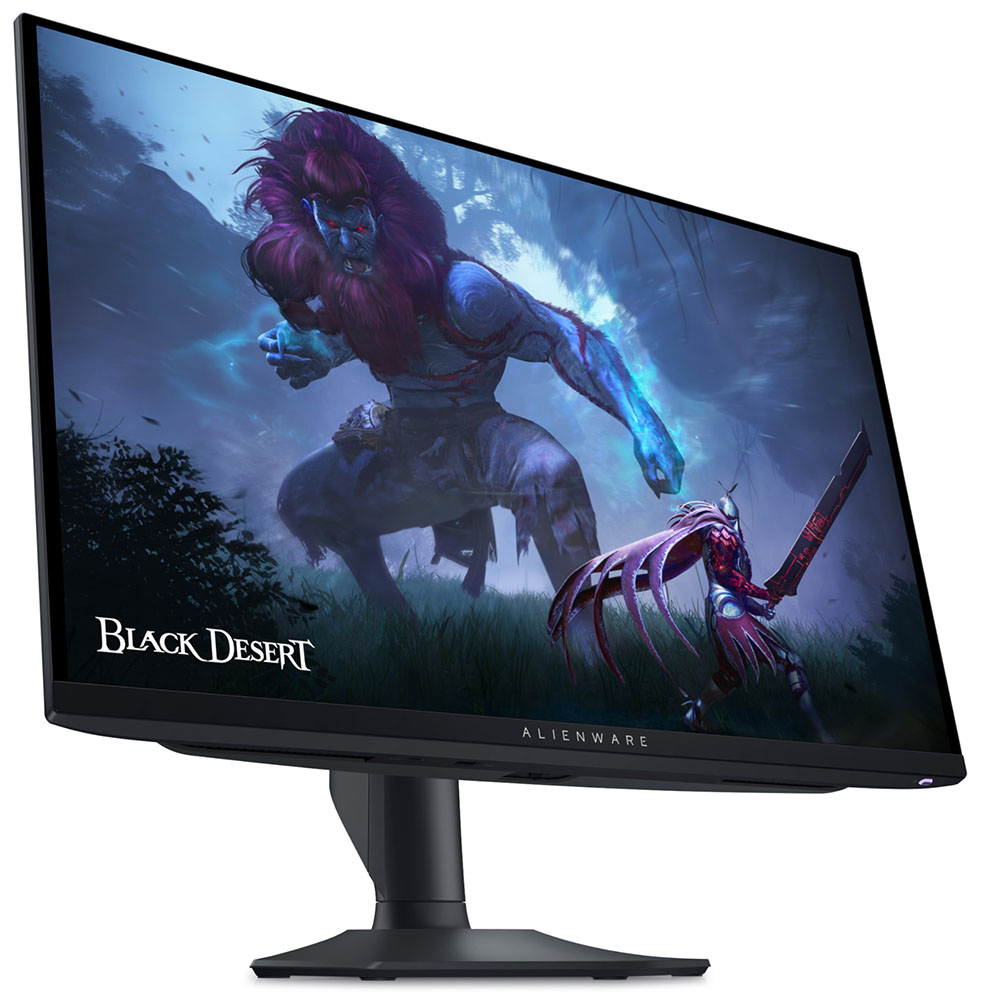
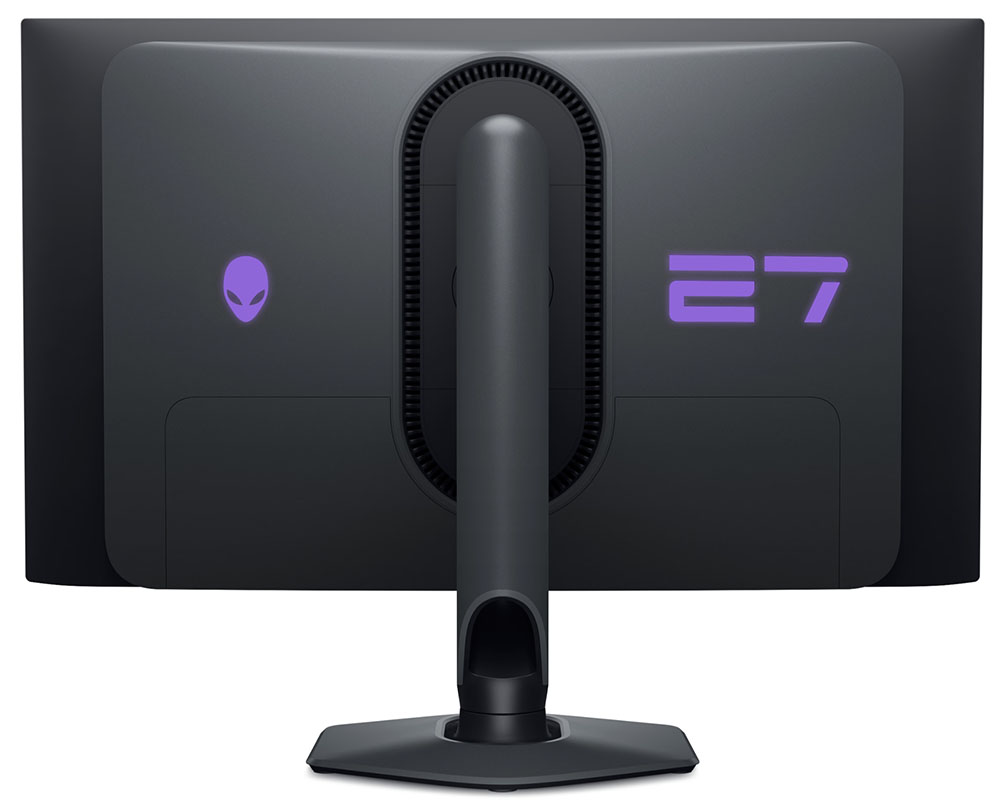

If you’re sorting OLED screens by their method of glare reduction, the AW2725DF is in the glossy category, like nearly all the OLEDs I’ve reviewed. Since it’s relatively small, finding a good spot that avoids reflection isn't too hard, but you’ll want to be thoughtful. If you have specular light sources like a sunny window or a backlit keyboard, you might see these things reflected on the screen. The upside is that it’s optically pure, which means the picture is razor-sharp. This is enhanced by the AW2725DF’s tremendous contrast and highly saturated color. The bezel is flush and thin, with just a small Alienware label and a glowing power LED at the right.
The back is smooth, with a bulge for internal components that is ventilated around its perimeter. The lighting is diffuse, with an Alienware logo and “27” in large numerals. The stand can be removed to reveal a 100mm VESA mount for aftermarket arms. The upright features full ergonomics, with 5/21 degrees tilt, 20 degrees swivel, and a 4.3-inch (110mm) height adjustment. Controls consist of a backlit power button at the right and a joystick/button underneath the center.
The input panel is up and under, and once you’ve made connections, it can be concealed by a snap-on cover for a clean look. There are two DisplayPort 1.4 and one HDMI 2.1. The former supports QHD resolution up to 360 Hz, while the latter tops out at 144 Hz with VRR support for consoles. There is a USB-C port, but it does not appear in the input list; it only supports charging and peripherals. Additional ports include one upstream and three downstream, version 3.2. There are no internal speakers, nor is there a traditional headphone jack. But you can plug USB-C cans into the port at the front, just to the left of the joystick.
OSD Features
Pressing the AW2725DF’s joystick brings up a quick menu that shows signal info at the top of the screen and a few quick options at the bottom. These can be programmed by the user. The full OSD appears with an additional up-click.
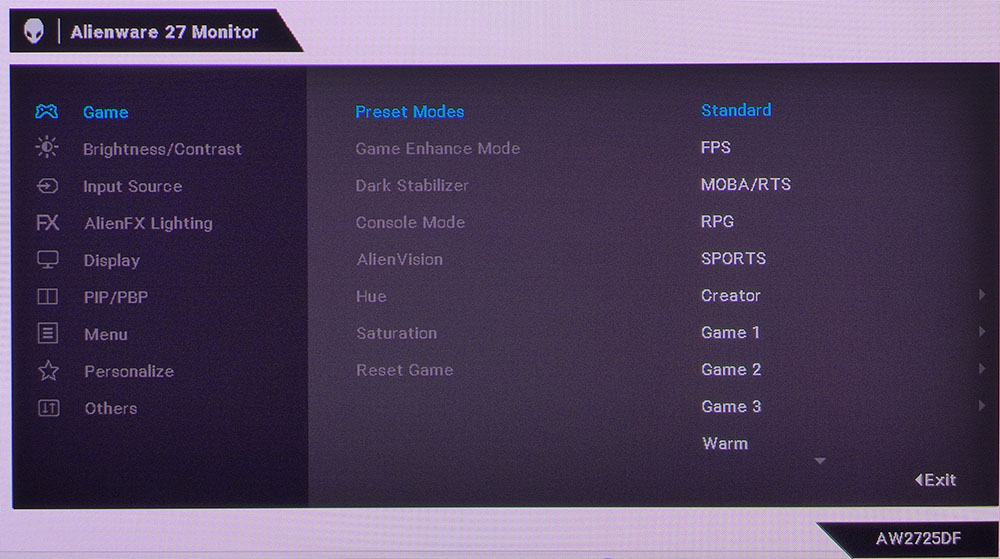
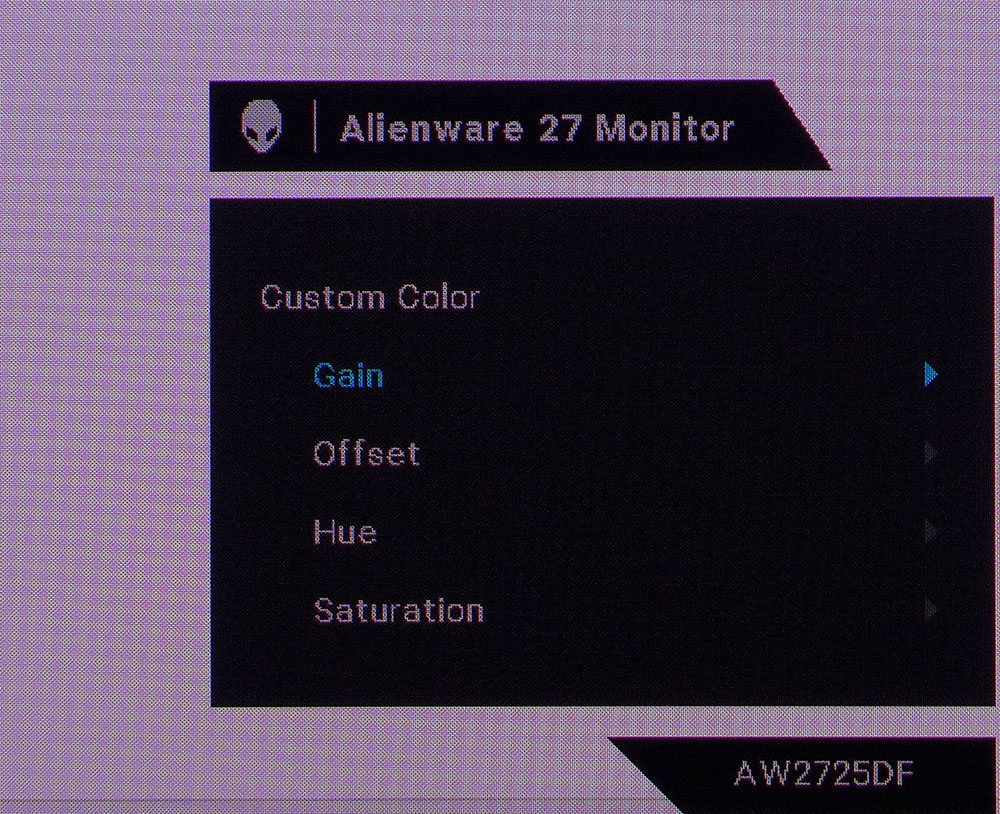
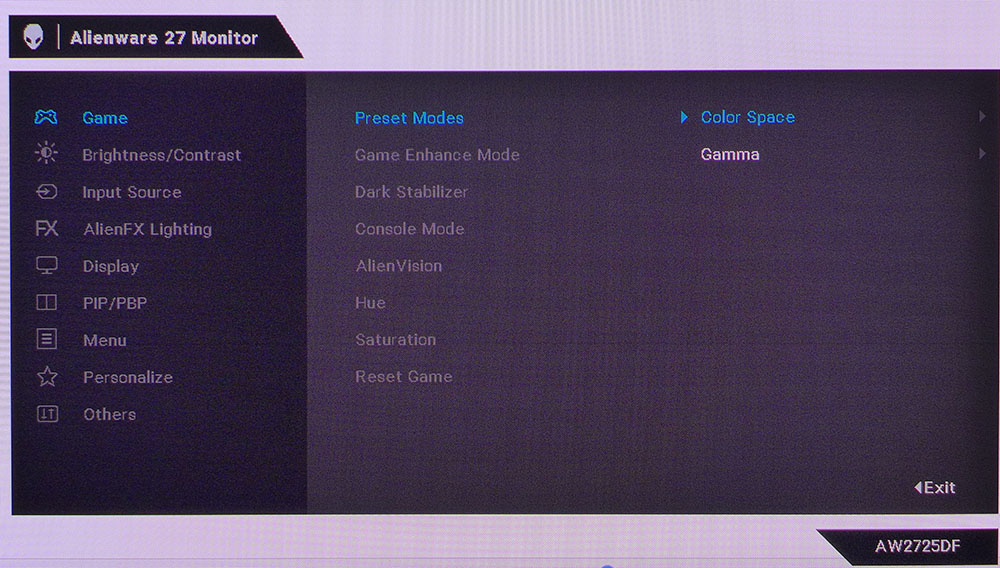
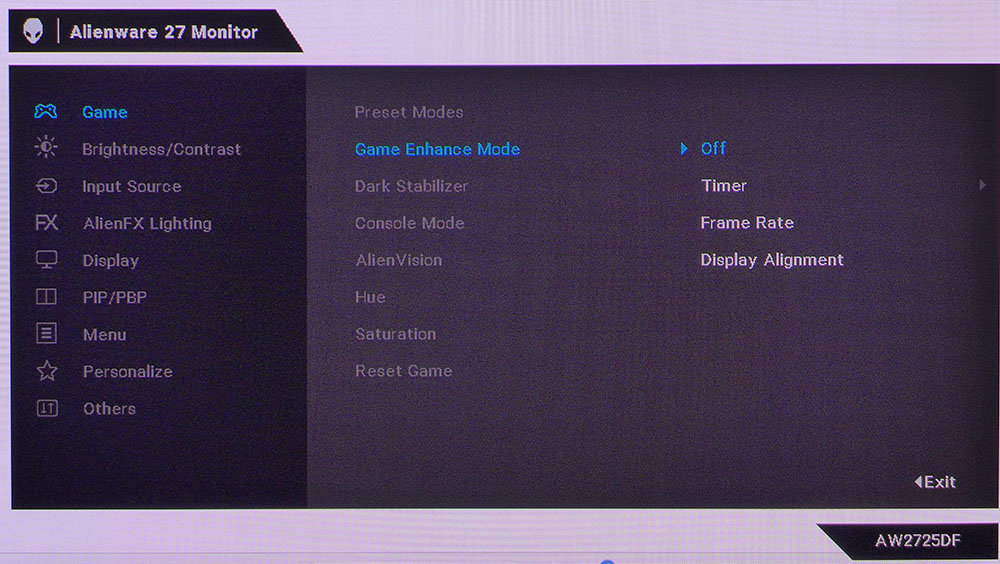
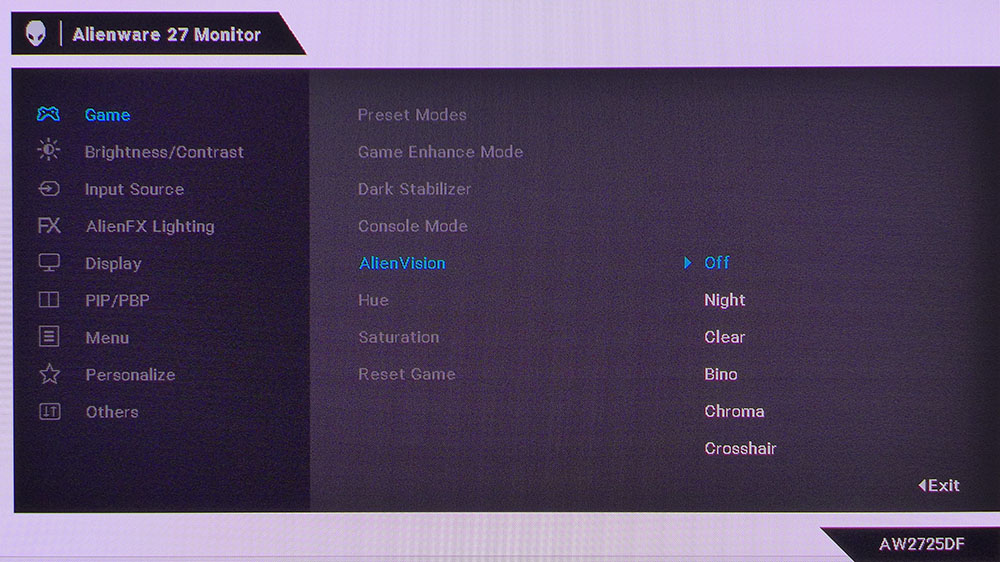
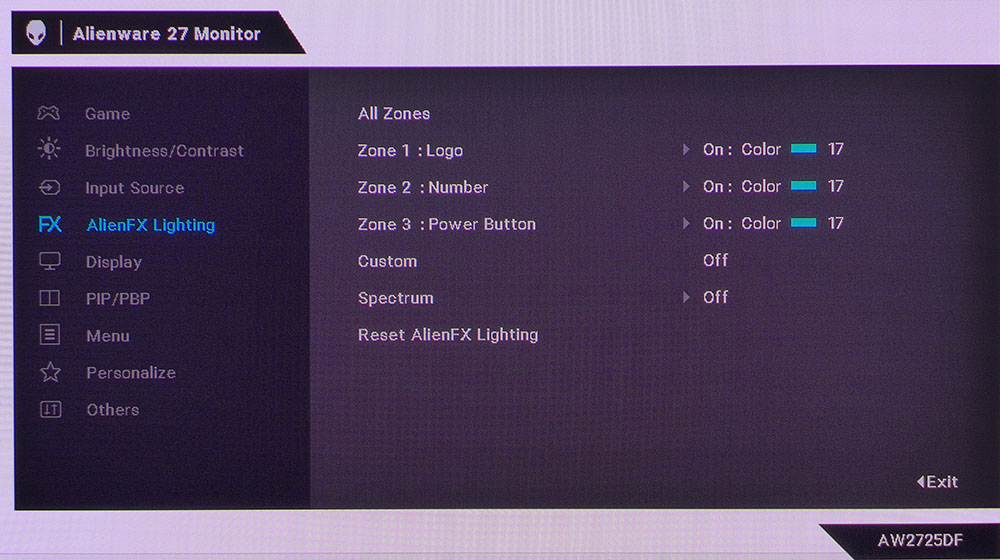
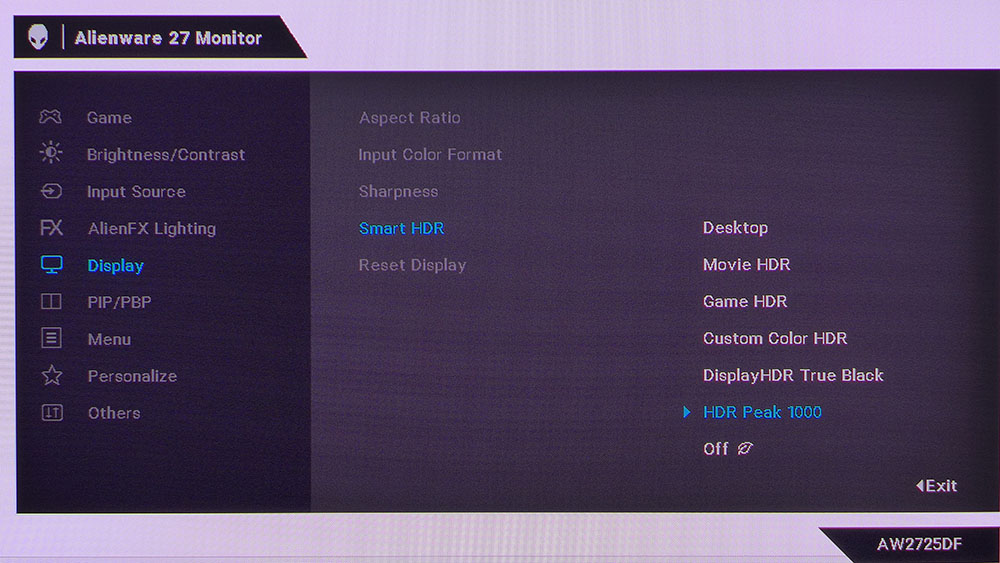
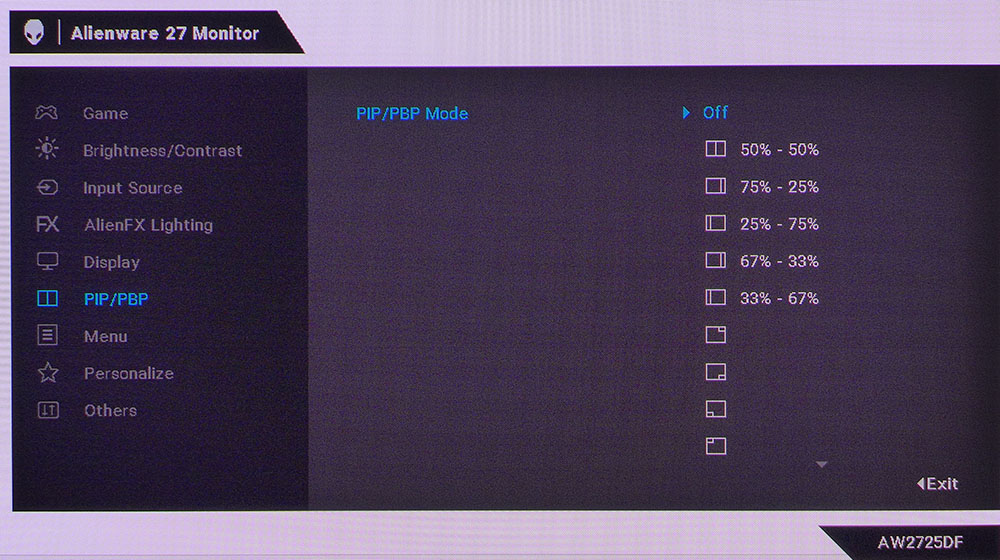
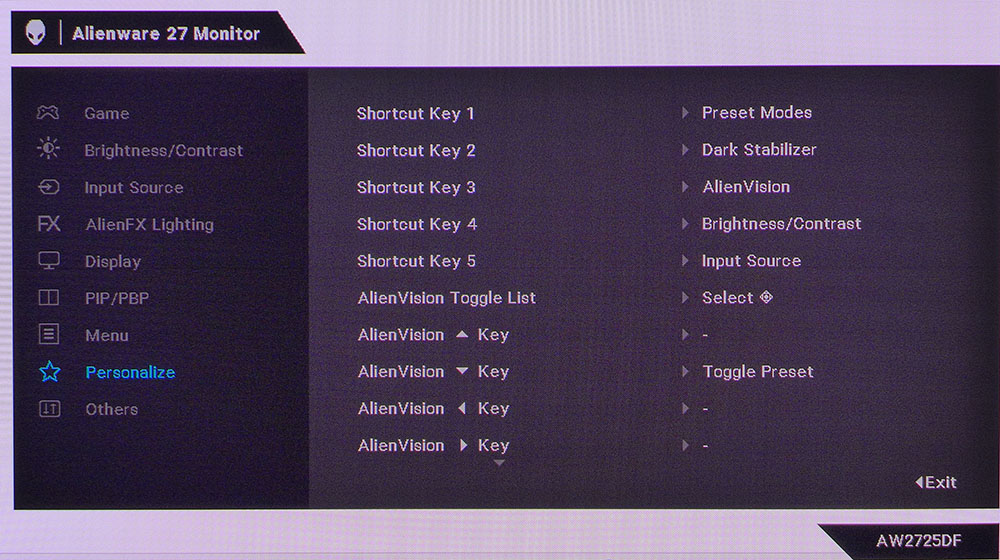
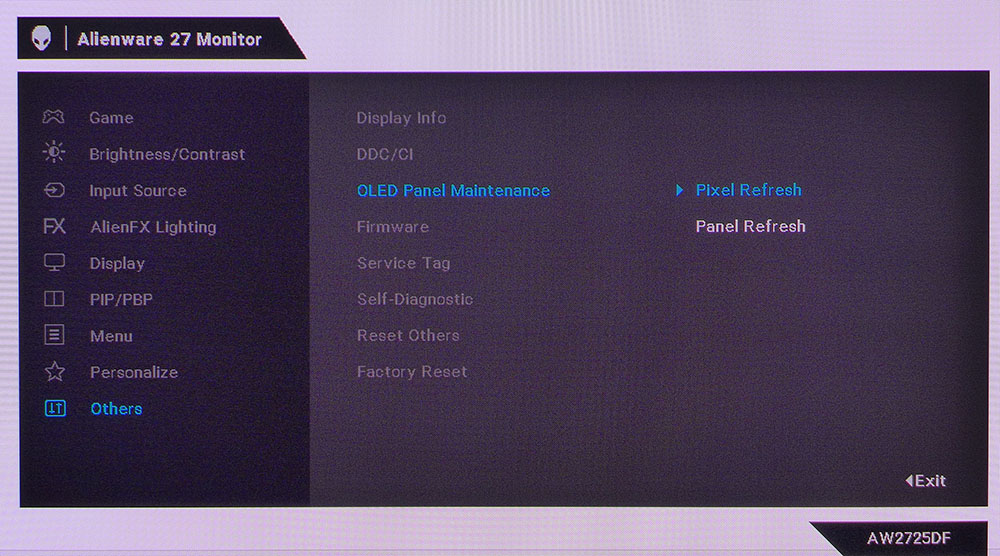
Apologies for the large number of photos but there is a lot going on here. The Game menu starts with 12 picture modes. Standard is the default and the basis for the AW2725DF’s calibration data sheet. It is very accurate out of the box and does not require adjustment. If you want to tweak, a Creator mode includes selectable gamma curves and color gamuts. That’s where you’ll find a very accurate sRGB option. Custom Color has two-point white balance and color management functions for an even more precise image. The Game Enhance Mode includes timers, a frame rate indicator and alignment marks. The aiming points and sniper aids are found under AlienVision.
AlienFX Lighting refers to the LEDs in the back and allows control of each logo and the power button. You can specify any color and a variety of effects. In the Display menu are the HDR modes called Smart HDR. The DisplayHDR True Black mode is the best-looking and most accurate. More about that on page five.
You can view two video sources simultaneously using PIP or PBP functions. The PIP window, available in two sizes, can be in any corner, and there are five screen portioning options for PBP. If you want to program the joystick directions, the Personalize menu has that ability. You can also create one-key access to the AlienVision modes. This lets you toggle sniper or aiming aids with a single click.
Finally, the AW2725DF includes full panel and pixel refresh routines to fight burn-in. I have not experienced this phenomenon with my LG television or any of the OLED monitors I’ve reviewed. A panel health indicator in the OSD lets you know when it’s time to run the maintenance.
Alienware AW2725DF Calibration Settings
The AW2725DF’s Standard picture mode is accurate enough not to require calibration. You will see the full native gamut for all content, which covers over 110% of DCI-P3. That’s well past the SDR's sRGB spec, but most users will be happy for the extra color. If you want sRGB, choose the Creator mode and specify that gamut. Note that the other option there, DCI-P3, is the theater spec which has a very green white point. It is unsuitable for gaming or video unless the content is mastered to the actual DCI standard. My advice is to stick with Standard or Custom Color or sRGB. Recommended SDR settings are below. In HDR mode, the True Black option shows the most detail and is the most color-accurate for all HDR content.
| Picture Mode | Custom Color |
| Brightness 200 nits | 97 |
| Brightness 120 nits | 62 |
| Brightness 100 nits | 50 |
| Brightness 80 nits | 38 |
| Brightness 50 nits | 21 (min. 17 nits) |
| Contrast | 75 |
| Color Temp User | Gain – Red 98, Green 98, Blue 100 |
| Row 8 - Cell 0 | Bias – Red 50, Green 50, Blue 50 |
Gaming and Hands-on
Since the AW2725DF is my first look at a 360 Hz OLED, I wanted to know what frame rates were possible using the GeForce RTX 4090 in my testbed PC. Playing Doom Eternal on max detail put enough demand on the system that it couldn’t quite sustain 360fps, but I never saw anything below 320. Even though QHD resolution presents an easier load than Ultra HD, you’ll still need some horsepower to drive the AW2725DF over 300fps.
You’ll want to do that because its smoothness and response at those speeds are simply amazing. I was sure the AW2725DF had raised my midi-chlorian count because I seemed to be able to mow down enemies with little to no effort. Input lag is perceptually non-existent, and no matter how quickly I moved, detail remained perfectly rendered. There is absolutely no softness or motion blur, regardless of the situation. Taken purely as a gaming monitor, the AW2725DF has few, if any, equals.
The image was stunning in every respect. I know that’s something I say about all OLEDs, but that doesn’t make it untrue. No LCD technology can deliver the deep blacks, broad contrast and perceptual color saturation of an OLED like the AW2725DF. Its larger than average color gamut showed up in everything I did, HDR and SDR. SDR games like Tomb Raider were extremely colorful, almost too much so since that title is mastered in the sRGB space. But I can’t bring myself to say there’s too much color, even when there is. I never felt the need for the sRGB mode when playing SDR games.
It was handy when returning to the workday, though. Photo and graphics editing is easier when you have a usable sRGB mode available. The AW2725DF’s is spot-on at reference level. The Creator mode is a handy tool. If your work extends to the film industry, the DCI-P3 mode matches the cinema spec and can be used for post-production. While most pros will have a high-end mastering monitor available for this, it’s nice to know you can get much the same performance from the $900 AW2725DF rather than something like SmallHD’s 4K 27-inch OLED that costs $11,999.
Mini LED screens might have higher brightness, but in practice, the AW2725DF had more than enough light output for my office and its sunlit window. I had to take some care to place it where the screen would not pick up reflections but other than that, there is no reason I couldn’t use this display every day for any task. It’s a great productivity tool that happens to be one of the best gaming monitors out there.
Takeaway: When considering 27-inch flat gaming monitors, I can’t imagine anything better than the AW2725DF. It delivers a stunning image for SDR and HDR and has otherworldly smoothness and response. It does everything well thanks to superb sharpness, contrast and color saturation.
MORE: How We Test PC Monitors
MORE: How to Buy a PC Monitor
Current page: Features and Specifications
Next Page Response, Input Lag, Viewing Angles and Uniformity
Christian Eberle is a Contributing Editor for Tom's Hardware US. He's a veteran reviewer of A/V equipment, specializing in monitors. Christian began his obsession with tech when he built his first PC in 1991, a 286 running DOS 3.0 at a blazing 12MHz. In 2006, he undertook training from the Imaging Science Foundation in video calibration and testing and thus started a passion for precise imaging that persists to this day. He is also a professional musician with a degree from the New England Conservatory as a classical bassoonist which he used to good effect as a performer with the West Point Army Band from 1987 to 2013. He enjoys watching movies and listening to high-end audio in his custom-built home theater and can be seen riding trails near his home on a race-ready ICE VTX recumbent trike. Christian enjoys the endless summer in Florida where he lives with his wife and Chihuahua and plays with orchestras around the state.
-
cknobman While amazing I wont buy into an OLED monitor until they are $500 or less.Reply
Not into spending 900+ on a computer monitor for gaming. -
oofdragon HYEAH this is what Im talking about!! When they come out with a 144hz in 2024 I just believe they deserve to lose money and end up selling those at a loss after they gathered dust so long on the shelves that they must give it a brutal discount in order to clean inventory. Make it 240hz minimum or gtfo. Now this 360hz may cost $900 but this is also the price of a GPU to run games on it at 360fps, if gaming is something important for you save for it, work double shifts, buy it and enjoy. I don't think there's much of a noticeable difference from a monitor like this vs a 240hz, there are some pennies tombe saved going for the lower Hz if you insist. My next monitor though.. I want it even 480hz! Lol. Like I'm okay selling my 240hz to get the 360hz and when the 480hz is out I'll sell it again. We are going to die anyways people, if the tech is here let us enjoy it.Reply -
amco_krkic Reply
i agree. Been looking into OLED monitors as after 14 years of gaming on 1080p im now looking to invest into a 1440p monitor. 1440p monitors at 165hz (which i believe is the sweet spot for refresh rate along with the res) are all priced at around £250 $300 on average with fast IPS panels. Now yes OLED compared to IPS there is a big difference in colouring, blackness, contrast etc. but i believe the downsides with OLED panels outweigh the positives when comparing them to IPS/Fast IPS/Fast IPS Nano colour, as with OLEDs you can get Screen burn ins, the cheaper OLED monitor panels are no where near as bright as the more premium priced ones which ruins the whole OLED experience as people in most cases are buying OLED for colours, contrast and HDR so even if you do invest into a cheap OLED monitor the low peak brightness will ruin the experience, and the biggest downside of them all when looking into anything is the price. Down the line i will most likely be looking into an OLED gaming monitor to experience the so called ''New era of gaming monitors'' but ONLY when the companies which are manufacturing the OLED panels invest money into better technology to reduce chances of screen burns, right now im only seeing ASUS who have implented this kind of technology on their OLED panels by implementing a panel heatsink but even then it only reduces the temperature by 5% compared to other OLED panels but even then it is not a significant improvement, and also of course i will not be buying an OLED monitor until they are actually AFFORDABLE.cknobman said:While amazing I wont buy into an OLED monitor until they are $500 or less.
Not into spending 900+ on a computer monitor for gaming. -
amco_krkic Reply
so i just settled with an Alienware AW2723DF monitor :LOL:cknobman said:While amazing I wont buy into an OLED monitor until they are $500 or less.
Not into spending 900+ on a computer monitor for gaming. -
amerelium Replyoofdragon said:HYEAH this is what Im talking about!! When they come out with a 144hz in 2024 I just believe they deserve to lose money and end up selling those at a loss after they gathered dust so long on the shelves that they must give it a brutal discount in order to clean inventory. Make it 240hz minimum or gtfo. Now this 360hz may cost $900 but this is also the price of a GPU to run games on it at 360fps, if gaming is something important for you save for it, work double shifts, buy it and enjoy. I don't think there's much of a noticeable difference from a monitor like this vs a 240hz, there are some pennies tombe saved going for the lower Hz if you insist. My next monitor though.. I want it even 480hz! Lol. Like I'm okay selling my 240hz to get the 360hz and when the 480hz is out I'll sell it again. We are going to die anyways people, if the tech is here let us enjoy it.
...you don't have to run games at 360 hz - you can run them at 120 hz, wich is more than enough, and enjoy the proper colours, contrasts, and blacks.
